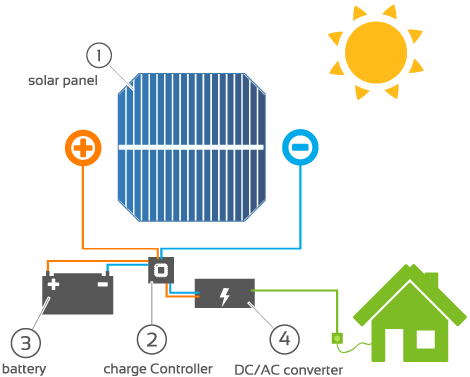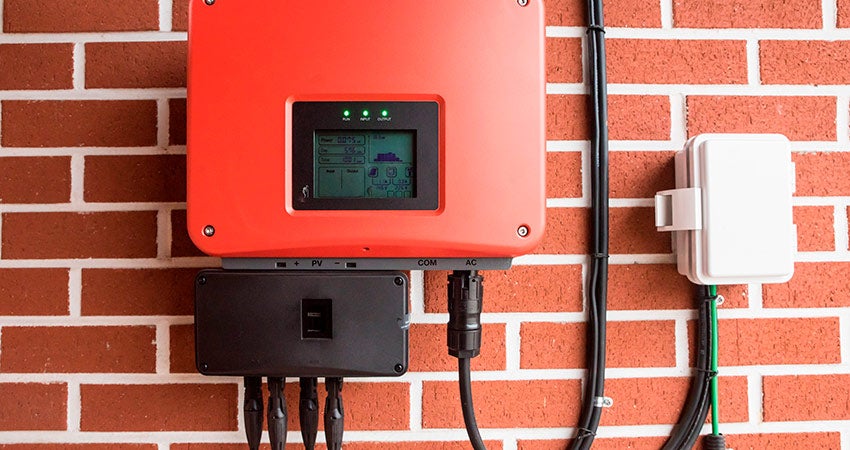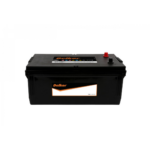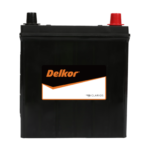
Around the globe, more homeowners are electing to install solar power systems (solar panel system). Their motivation is to reduce long-term energy costs while minimizing their carbon footprint. Clean, renewable, and affordable, solar energy is clearly the energy of the future as witnessed by the rapid growth throughout North America, Europe, China, and even India.

According to a report by SEIA, a record amount of residential solar capacity was installed in Q3 2019, and overall growth for 2019 is estimated at 23%. Growth is expected to continue in the coming years. This rapid development has stemmed mostly from improvements in the efficiency and lower cost of the latest solar power systems.
So, what is needed to create an efficient solar power system for home use? What equipment is required? What will be the investment and savings? And when will break-even occur?
What is a solar panel system?
Roof-mounted solar panel systems absorb and convert the energy-packed photons of natural sunlight into a usable energy form. The solar panel systems are often referred to as a PV or photovoltaic solar power systems.
Home installation of a high-quality solar power system can reduce or eliminate dependence on the community power grid for electricity to light, heat, cool, and operate your home. The result is a clean, renewable energy source that requires little maintenance and will pay back the initial investment in just a few years.
Over the longer term, a system that comes with a 25-year warranty, say, will provide decades of free energy.
What are the main components of a solar panel system?

Understanding the components of a solar power system is the first step. The components of a home solar power or PV system are:
Solar panels: The solar panels themselves are the key elements of a solar power system. The essential attributes to consider are the efficiency, cost, warranty, and technology type. SolarReviews produces an extensive, unbiased list of leading solar panel brands from around the world comparing attributes such as efficiency and warranty.
- The two types of solar panels most suitable for residential solar installations are monocrystalline and polycrystalline. These perform similarly although the monocrystalline is slightly more efficient and a little more expensive.
- The number and placement of solar panels are dependent on your energy requirements, useable roof surface area, climate and peak sunlight in your location, the efficiency rating of the solar panels, and whether net metering is available. There is also usually the potential for actually returning power to the grid for credit and being given a full one for one credit for it under the scheme known as net metering.
- A professional solar installer can help calculate the number of solar panels to create the most cost-effective system or you can use the solar system size calculator on this site.
Solar inverter: Inverters are the mechanisms that convert the Direct Current (DC) produced by the solar panels into the Alternating Current (AC) that homes require. Inverters come in three types:
- String or centralized inverters: least expensive, but can be inefficient.
- Micro-inverters: more expensive, attached to each solar panel allowing for smooth operations even when some panels are shaded.
- Power Optimizers: installed in each panel, these direct DC to a central inverter for conversion to AC. Less expensive than micro-inverters, but slightly more than string-type.
Solar racking: Panels are not attached to the roof directly. Panels are mounted in racking which is attached to the roof and angled for the optimal degree of sun exposure.
Solar performance monitoring: To verify the performance of your PV system, a monitoring system will show the homeowner how much electricity is being generated per hour. The system can identify potential performance changes.
Solar storage options: Solar batteries can be installed to store energy for later or simply overnight. Alternatively, in some communities, net metering is available that allows excess energy to be sent to the grid for credit. In essence, you will be using the grid as your excess storage option. It is like having a solar battery installed without the cost.
How much will the solar power system cost?
As mentioned, a few variables can be assessed to determine the right system for any residential application. Understand that the equipment may not be the most expensive component since the professional installation requires time, training, expertise, and materials. Also keep in mind that while a typical payback may be approximately 6-7 years, some manufacturers offer a 25-year warranty. Imagine the utility costs you could save over the course of at least two decades.
And, as part of the calculation, keep in mind that the IRS offers a substantial tax credit on your solar panel system while some states offer additional incentives.
Our solar calculator incorporates initial costs plus long-term savings to help with your decision.
Who should I use to install my solar system for home?
Proper installation can be as critical to future performance and return on your investment as the quality of the equipment. Extensive training and a complete understanding of each element are essential. The best manufacturers have identified and partnered with the qualified installers in each geographic area. These companies provide onsite training and verification of professional installers before certification.
What is the best solar power system for residential?
While many manufacturers believe they are the “best,” one way to verify the best choice is to refer to comparisons by reputable sources. Two essential elements to consider for long-term value are a) efficiency and the b) length of the warranty.
- Efficiency is a determinant of how solar energy from the sun is converted to electricity per square foot. According to several solar websites, including SolarReviews, SunPower solar systems lead all others in terms of solar panel efficiency but their solar panels are also sold at quite a premium over other very good solar panels that are almost as efficient.
- Length of warranty is a function of the confidence the manufacturer has in their products and an assurance that you are covered if something should happen. Many companies offer only a 5 or 10-year product warranty and a 25-year power output warranty, while SunPower provides an industry-leading 25-year protection on performance, labor, and parts, as well as a high level of warranted power output.




